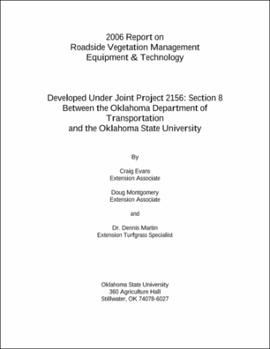| dc.description.abstract | The objective of this report is to provide Oklahoma Department of Transportation (ODOT) personnel with recommendations concerning the utilization of new technologies and/or adaptations of existing technology. This will enable vegetation managers to comply with ODOT抯 need to provide safe travel corridors for Oklahoma抯 motoring public. In recent years, Oklahoma agricultural producers have been exploring the production of non-traditional, high value crops to circumvent the low returns per acre from traditional crops such as wheat. Some of new cropping options include grape production and organic crop/livestock production on small to large acreages adjacent to or in close proximity to ODOT managed rights-of-way. Grapes along with some other crops have been labeled as 搖ltra sensitive� to some herbicides used for vegetation management on ODOT easements. Consistent with the ODOT 揋ood Neighbor� policy, ODOT has initiated a 搉o spray� buffer around vineyards. These buffer zones may be of varying sizes. Additionally, the buffer zone concept may also be expanded to include other sensitive crop areas such as those containing cotton. Widespread presence of sensitive crops and subsequent no-spray buffer zones will necessitate a different approach to management of non-desirable vegetation in these zones. The option for use of the Speidel Weed Wiper was elaborated upon in the report �99 Annual ODOT Report on Roadside Vegetation Management Equipment: Project 2130: Section 2� that was presented to ODOT as part of the joint continuing effort between the Oklahoma State University RVM (Roadside Vegetation Management) Program and ODOT. The main focus of the findings in that report where the need for ODOT to control switchgrass infestations in clear zones/safety zones and johnsongrass in wildflower plantings. Both issues continue to be management concerns for ODOT to this day and wiper recommendations are contained in the current Oklahoma Cooperative Extension Service circular E-958, September 2006. In addition to switchgrass and johnsongrass concerns, wiper use with glyphosate has new possibilities for reducing the potential of herbicide drift onto adjacent ultra-sensitive crops. Due to the very low volatility of glyphosate, vapor drift is virtually nonexistent. The Speidel Weed Wiper, because of its design to wipe rather than spray glyphosate, can be safely used in areas immediately adjacent to sensitive crop sites. Some ODOT herbicide applicators may have concluded that the Speidel Wiper technology was not very practical or viable. This conclusion may have been drawn based on the following assumptions: 1.) Long wiper booms (10� were cumbersome and did not conform to easement surface contours, both concave and convex situations, which resulted in gaps in the wiping pattern or the wiper bar possibly 揵ottoming out� and hitting the soil surface. 2.) The operator may have had to dismount from the tractor and manually adjust the wiper height to successfully apply the glyphosate to the weed target due to a frequent need to change the height of wiper boom. 3.). Due to the long turning radius of conventional tractors, movement within the highway easement was restricted and this may have required the operator to traverse the highway surface which increases the risk of motorist vehicle-tractor operator collision. ACR Sales (Norman, OK) has developed a simple mounting bracket system for ATV/utility vehicles that enables the ATV operator to make wiper-bar height adjustments without dismounting the ATV. This ability saves valuable man-hours and increases the acres per hour treated as well as the acres per application event treated. The relatively tight turning radius of these types� vehicles also allows the operator more safety by allowing them to stay in the easement and off of the highway itself. The multi-tasking capabilities of the utility vehicles are also a very appealing feature that has perpetuated their use in the Texas Department of Transportation (TXDOT) maintenance fleet. The TXDOT utilizes approximately 30 utility vehicles state-wide for vegetation management (personal consultation, Steve Prather, TxDOT, December 11, 2006 and Robert Watts, District Vegetation Manager, TxDOT Odessa District, December 12, 2006). | |
